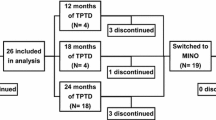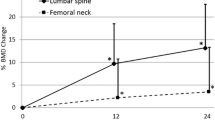Abstract
Summary
Treatment effects over 2 years of teriparatide vs. ibandronate in postmenopausal women with osteoporosis were compared using lumbar spine bone mineral density (BMD) and trabecular bone score (TBS). Teriparatide induced larger increases in BMD and TBS compared to ibandronate, suggesting a more pronounced effect on bone microarchitecture of the bone anabolic drug.
Introduction
The trabecular bone score (TBS) is an index of bone microarchitecture, independent of bone mineral density (BMD), calculated from anteroposterior spine dual X-ray absorptiometry (DXA) scans. The potential role of TBS for monitoring treatment response with bone-active substances is not established. The aim of this study was to compare the effects of recombinant human 1–34 parathyroid hormone (teriparatide) and the bisphosphonate ibandronate (IBN), on lumbar spine (LS) BMD and TBS in postmenopausal women with osteoporosis.
Methods
Two patient groups with matched age, body mass index (BMI), and baseline LS BMD, treated with either daily subcutaneous teriparatide (N = 65) or quarterly intravenous IBN (N = 122) during 2 years and with available LS BMD measurements at baseline and 2 years after treatment initiation were compared.
Results
Baseline characteristics (overall mean ± SD) were similar between groups in terms of age 67.9 ± 7.4 years, body mass index 23.8 ± 3.8 kg/m2, BMD L1–L4 0.741 ± 0.100 g/cm2, and TBS 1.208 ± 0.100. Over 24 months, teriparatide induced a significantly larger increase in LS BMD and TBS than IBN (+7.6 % ± 6.3 vs. +2.9 % ± 3.3 and +4.3 % ± 6.6 vs. +0.3 % ± 4.1, respectively; P < 0.0001 for both). LS BMD and TBS were only weakly correlated at baseline (r 2 = 0.04) with no correlation between the changes in BMD and TBS over 24 months.
Conclusions
In postmenopausal women with osteoporosis, a 2-year treatment with teriparatide led to a significantly larger increase in LS BMD and TBS than IBN, suggesting that teriparatide had more pronounced effects on bone microarchitecture than IBN.

Similar content being viewed by others
References
Czerwinski E, Badurski JE, Marcinowska-Suchowierska E, Osieleniec J (2007) Current understanding of osteoporosis according to the position of the World Health Organization (WHO) and International Osteoporosis Foundation. Ortop Traumatol Rehabil 9:337–356
Cooper C, Reginster JY, Cortet B, Diaz-Curiel M, Lorenc RS, Kanis JA, Rizzoli R (2012) Long-term treatment of osteoporosis in postmenopausal women: a review from the European Society for Clinical and Economic Aspects of Osteoporosis and Osteoarthritis (ESCEO) and the International Osteoporosis Foundation (IOF). Curr Med Res Opin 28:475–491
Dhanwal DK, Dennison EM, Harvey NC, Cooper C (2011) Epidemiology of hip fracture: worldwide geographic variation. Indian J Orthop 45:15–22
Burge R, Dawson-Hughes B, Solomon DH, Wong JB, King A, Tosteson A (2007) Incidence and economic burden of osteoporosis-related fractures in the United States, 2005–2025. J Bone Miner Res 22:465–475
Johnell O, Kanis JA (2006) An estimate of the worldwide prevalence and disability associated with osteoporotic fractures. Osteoporos Int 17:1726–1733
NIH (2001) Consensus development panel on osteoporosis prevention, diagnosis, and therapy, March 7–29, 2000: highlights of the conference. South Med J 94:569–573
American College of Rheumatology Ad Hoc Committee on Glucocorticoid-Induced Osteoporosis (2001) Recommendations for the prevention and treatment of glucocorticoid-induced osteoporosis: 2001 update. Arthritis Rheum 44:1496–1503
Tucci JR (2006) Importance of early diagnosis and treatment of osteoporosis to prevent fractures. Am J Manag Care 12:S181–S190
Report of a WHO Study Group (1994) Assessment of fracture risk and its application to screening for postmenopausal osteoporosis. World Health Organ Tech Rep Ser 843:1–129
Johnell O, Kanis JA, Oden A et al (2005) Predictive value of BMD for hip and other fractures. J Bone Miner Res 20:1185–1194
Hordon LD, Raisi M, Aaron JE, Paxton SK, Beneton M, Kanis JA (2000) Trabecular architecture in women and men of similar bone mass with and without vertebral fracture: I. Two-dimensional histology. Bone 27:271–276
Link TM, Majumdar S (2004) Current diagnostic techniques in the evaluation of bone architecture. Curr Osteoporos Rep 2:47–52
Rubin CD (2005) Emerging concepts in osteoporosis and bone strength. Curr Med Res Opin 21:1049–1056
Dalle Carbonare L, Giannini S (2004) Bone microarchitecture as an important determinant of bone strength. J Endocrinol Invest 27:99–105
Hans D, Barthe N, Boutroy S, Pothuaud L, Winzenrieth R, Krieg MA (2011) Correlations between trabecular bone score, measured using anteroposterior dual-energy X-ray absorptiometry acquisition, and 3-dimensional parameters of bone microarchitecture: an experimental study on human cadaver vertebrae. J Clin Densitom 14:302–312
Pothuaud L, Barthe N, Krieg MA, Mehsen N, Carceller P, Hans D (2009) Evaluation of the potential use of trabecular bone score to complement bone mineral density in the diagnosis of osteoporosis: a preliminary spine BMD-matched, case-control study. J Clin Densitom 12:170–176
Pothuaud L, Carceller P, Hans D (2008) Correlations between grey-level variations in 2D projection images (TBS) and 3D microarchitecture: applications in the study of human trabecular bone microarchitecture. Bone 42:775–787
Silva BC, Boutroy S, Zhang C et al (2013) Trabecular bone score (TBS)—a novel method to evaluate bone microarchitectural texture in patients with primary hyperparathyroidism. J Clin Endocrinol Metab 98:1963–1970
Del Rio LM, Winzenrieth R, Cormier C, Di Gregorio S (2013) Is bone microarchitecture status of the lumbar spine assessed by TBS related to femoral neck fracture? A Spanish case–control study. Osteoporos Int 24:991–998
Krueger D, Fidler E, Libber J, Aubry-Rozier B, Hans D, Binkley N (2013) Spine trabecular bone score subsequent to bone mineral density improves fracture discrimination in women. J Clin Densitom. doi:10.1016/j.jocd.2013.05.001
Boutroy S, Hans D, Sornay-Rendu E, Vilayphiou N, Winzenrieth R, Chapurlat R (2013) Trabecular bone score improves fracture risk prediction in non-osteoporotic women: the OFELY study. Osteoporos Int 24:77–85
Iki M, Tamaki J, Kadowaki E, Sato Y, Dongmei N, Winzenrieth R, Kagamimori S, Kagawa Y, Yoneshima H (2013) Trabecular bone score (TBS) predicts vertebral fractures in Japanese women over 10years independently of bone density and prevalent vertebral deformity: the Japanese population-based osteoporosis (JPOS) cohort study. J Bone Miner Res
Briot K, Paternotte S, Kolta S, Eastell R, Reid DM, Felsenberg D, Gluer CC, Roux C (2013) Added value of trabecular bone score to bone mineral density for prediction of osteoporotic fractures in postmenopausal women: The OPUS study. Bone 57:232–236
Hans D, Goertzen AL, Krieg MA, Leslie WD (2011) Bone microarchitecture assessed by TBS predicts osteoporotic fractures independent of bone density: the Manitoba study. J Bone Miner Res 26:2762–2769
Krieg MA, Aubry-Rozier B, Hans D, Leslie WD, Manitoba Bone Density P (2013) Effects of anti-resorptive agents on trabecular bone score (TBS) in older women. Osteoporos Int 24:1073–1078
Popp AW, Guler S, Lamy O, Senn C, Buffat H, Perrelet R, Hans D, Lippuner K (2013) Effects of zoledronate versus placebo on spine bone mineral density and microarchitecture assessed by the trabecular bone score in postmenopausal women with osteoporosis: a three-year study. J Bone Miner Res 28:449–454
Neer RM, Arnaud CD, Zanchetta JR et al (2001) Effect of parathyroid hormone (1–34) on fractures and bone mineral density in postmenopausal women with osteoporosis. N Engl J Med 344:1434–1441
Saag KG, Shane E, Boonen S, Marin F, Donley DW, Taylor KA, Dalsky GP, Marcus R (2007) Teriparatide or alendronate in glucocorticoid-induced osteoporosis. N Engl J Med 357:2028–2039
Chen P, Miller PD, Recker R, Resch H, Rana A, Pavo I, Sipos AA (2007) Increases in BMD correlate with improvements in bone microarchitecture with teriparatide treatment in postmenopausal women with osteoporosis. J Bone Miner Res 22:1173–1180
Arita S, Ikeda S, Sakai A, Okimoto N, Akahoshi S, Nagashima M, Nishida A, Ito M, Nakamura T (2004) human parathyroid hormone (1–34) increases mass and structure of the cortical shell, with resultant increase in lumbar bone strength, in ovariectomized rats. J Bone Miner Metab 22:530–540
Chen P, Jerome CP, Burr DB, Turner CH, Ma YL, Rana A, Sato M (2007) Interrelationships between bone microarchitecture and strength in ovariectomized monkeys treated with teriparatide. J Bone Miner Res 22:841–848
Recker RR, Ste-Marie LG, Langdahl B, Czerwinski E, Bonvoisin B, Masanauskaite D, Rowell L, Felsenberg D (2010) Effects of intermittent intravenous ibandronate injections on bone quality and micro-architecture in women with postmenopausal osteoporosis: the DIVA study. Bone 46:660–665
Hans D, Downs RW Jr, Duboeuf F, Greenspan S, Jankowski LG, Kiebzak GM, Petak SM (2006) Skeletal sites for osteoporosis diagnosis: the 2005 ISCD official positions. J Clin Densitom 9:15–21
Black DM, Delmas PD, Eastell R et al (2007) Once-yearly zoledronic acid for treatment of postmenopausal osteoporosis. N Engl J Med 356:1809–1822
Lee YK, Nho JH, Ha YC, Koo KH (2012) Persistence with intravenous zoledronate in elderly patients with osteoporosis. Osteoporos Int 23:2329–2333
Lindsay R, Cosman F, Lobo RA, Walsh BW, Harris ST, Reagan JE, Liss CL, Melton ME, Byrnes CA (1999) Addition of alendronate to ongoing hormone replacement therapy in the treatment of osteoporosis: a randomized, controlled clinical trial. J Clin Endocrinol Metab 84:3076–3081
Rakel A, Boucher A, Ste-Marie LG (2011) Role of zoledronic acid in the prevention and treatment of osteoporosis. Clin Interv Aging 6:89–99
Reid DM, Hughes RA, Laan RF, Sacco-Gibson NA, Wenderoth DH, Adami S, Eusebio RA, Devogelaer JP (2000) Efficacy and safety of daily risedronate in the treatment of corticosteroid-induced osteoporosis in men and women: a randomized trial. European corticosteroid-induced osteoporosis treatment study. J Bone Miner Res 15:1006–1013
Seeman E, Delmas PD (2006) Bone quality—the material and structural basis of bone strength and fragility. N Engl J Med 354:2250–2261
Jiang Y, Zhao JJ, Mitlak BH, Wang O, Genant HK, Eriksen EF (2003) Recombinant human parathyroid hormone (1–34) [teriparatide] improves both cortical and cancellous bone structure. J Bone Miner Res 18:1932–1941
Jobke B, Muche B, Burghardt AJ, Semler J, Link TM, Majumdar S (2011) Teriparatide in bisphosphonate-resistant osteoporosis: microarchitectural changes and clinical results after 6 and 18months. Calcif Tissue Int 89:130–139
Fahrleitner-Pammer A, Langdahl BL, Marin F et al (2011) Fracture rate and back pain during and after discontinuation of teriparatide: 36-month data from the European Forsteo Observational Study (EFOS). Osteoporos Int 22:2709–2719
Finkelstein JS, Wyland JJ, Leder BZ, Burnett-Bowie SM, Lee H, Juppner H, Neer RM (2009) Effects of teriparatide retreatment in osteoporotic men and women. J Clin Endocrinol Metab 94:2495–2501
Trevisani VF, Riera R, Imoto AM, Saconato H, Atallah AN (2008) Teriparatide (recombinant human parathyroid hormone 1–34) in postmenopausal women with osteoporosis: systematic review. Sao Paulo Med J Rev Paul Med 126:279–284
Hadji P, Zanchetta JR, Russo L et al (2012) The effect of teriparatide compared with risedronate on reduction of back pain in postmenopausal women with osteoporotic vertebral fractures. Osteoporos Int 23:2141–2150
Jakob F, Oertel H, Langdahl B et al (2012) Effects of teriparatide in postmenopausal women with osteoporosis pre-treated with bisphosphonates: 36-month results from the European Forsteo Observational Study. Eur J Endocrinol 166:87–97
Keel C, Kraenzlin ME, Kraenzlin CA, Muller B, Meier C (2010) Impact of bisphosphonate wash-out prior to teriparatide therapy in clinical practice. J Bone Miner Metab 28:68–76
Acknowledgments
We are grateful to Philippe Kress, MD, for reviewing and commenting on our manuscript.
Conflicts of interest
Didier Hans is coowner of the TBS patent and has corresponding ownership shares. Christoph Senn, Beatrice Günther, Albrecht W. Popp, Romain Perrelet, and Kurt Lippuner declare that they have no conflict of interest.
Author information
Authors and Affiliations
Corresponding author
Additional information
D. Hans codirected equally the TBS study.
Rights and permissions
About this article
Cite this article
Senn, C., Günther, B., Popp, A.W. et al. Comparative effects of teriparatide and ibandronate on spine bone mineral density (BMD) and microarchitecture (TBS) in postmenopausal women with osteoporosis: a 2-year open-label study. Osteoporos Int 25, 1945–1951 (2014). https://doi.org/10.1007/s00198-014-2703-8
Received:
Accepted:
Published:
Issue Date:
DOI: https://doi.org/10.1007/s00198-014-2703-8




